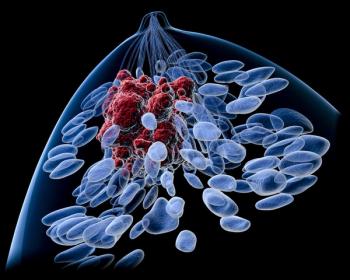
- Oncology Vol 28 No 1S
- Volume 28
- Issue 1S
(P108) A Dosimetric Comparison of Endorectal Brachytherapy, Tomotherapy, Linac-Based Stereotactic Body Radiotherapy (SBRT), and Cyberknife for the Delivery of a Rectal Tumor Boost
Neoadjuvant chemoradiation or a short course of pelvic radiation therapy followed by surgery is the standard of care for patients diagnosed with locally advanced rectal cancer. For patients who are not surgical candidates, delivery of a tumor boost is frequently considered. The present analysis compares dosimetry of endorectal brachytherapy (ERBT) with three different image-guided radiation therapy (IGRT) techniques.
Lorraine Portelance, MD, Neil Kopek, MD, Zhendong Wang, PhD; University of Miami Miller School of Medicine
Purpose: Neoadjuvant chemoradiation or a short course of pelvic radiation therapy followed by surgery is the standard of care for patients diagnosed with locally advanced rectal cancer. For patients who are not surgical candidates, delivery of a tumor boost is frequently considered. The present analysis compares dosimetry of endorectal brachytherapy (ERBT) with three different image-guided radiation therapy (IGRT) techniques-namely tomotherapy, linear accelerator (linac)-based stereotactic body radiotherapy (SBRT), and CyberKnife (CK) SBRT.
Materials and Methods: The planning CT scans of 10 patients who received ERBT were retrieved. These CT scans were acquired with an endorectal applicator in place, which distends the rectal wall and facilitates rectal immobilization and tumor localization. Using these planning CT scans, tomotherapy, seven-field linac-based SBRT, and CK dose distributions were generated for the same dose schedule that was used for the ERBT (26 Gy in four fractions, prescribed to the outermost tumor margin). All external beam plans were prescribed to an isodose envelope covering 95% of the target and ensuring 99% of the target receives a minimum of 90% of the prescribed dose. For this comparative dosimetric study, the planning target volume (PTV) was considered equal to the gross tumor volume (GTV) for all plans. One-way analysis of variance (ANOVA) testing was used to compare max and mean values observed for selected organs at risk.
Results: All modalities achieved complete coverage over the target by the prescription dose. The target near maximum dose (D2%) was 175.9 Gy, 27.0 Gy, 29.1 Gy, and 31.96 Gy for ERBT, tomotherapy, linac-based SBRT, and CK, respectively (P = .005). For the ERBT, tomotherapy, linac-based SBRT, and CK plans, the conformality index (prescription vol [cc]/target vol [cc]) was 4.1, 1.5, 1.5, and 1.2 (P = .01), respectively, and the homogeneity index ([D2%–D98%]/D50%) was 2.79, 0.03, 0.13, and 0.22 (P = .00), respectively.
Conclusions: All IGRT techniques (tomotherapy, linca-based SBRT, and CK) provided better target conformality and homogeneity compared with ERBT. The endocavitary brachytherapy plans were associated with significantly higher doses to the uninvolved rectal wall and adjacent anal canal. When considering the use of a tumor boost in the treatment of patients with unresectable rectal cancer, the IGRT techniques studied in this analysis offer better tissue sparing and CI than ERBT.
Articles in this issue
Newsletter
Stay up to date on recent advances in the multidisciplinary approach to cancer.

















































































